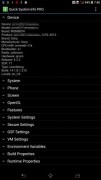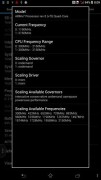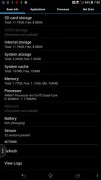Sony's tablet and smartphone divisions struggled in 2012, falling victim to the seemingly unstoppable legion of Samsung devices sweeping the market. But, unwilling to throw in the towel, the Japanese giant has come out swinging in 2013 and unveiled a host of new top-end Xperia devices. This started at the Consumer Electronics Show in Las Vegas in January, with Sony's Xperia Z smartphone, and continued in February when it unveiled the Xperia Tablet Z.
While the Z smartphone's poor battery life and less than stellar software additions hampered some of the device's more positive design and screen technologies, Sony promised that these flaws had been fixed for the Tablet Z. If true, the tablet could be a key competitor to Samsung and perhaps even Apple's iPad in the 2013 tablet market.
Design and build
The Z features the same OmniBalance design as its smaller sibling, the Xperia Z. This means the Tablet Z looks like a blown-up version of the Z smartphone, and features the same hard-lined, rectangular design. The back of the tablet is made of polycarbonate, while the front is made of Gorilla Glass. The use of polycarbonate is deceiving as it hides the Tablet Z's most interesting design feature, its IP57 certification. The certification means that, despite being built from polycarbonate, the Tablet Z is a very rugged device, being scratch, dust and water resistant.
For business users who travel regularly or work in industries that require them to be outdoors, the Tablet Z's IP57 certification is a definite boon. The Tablet Z's travel-friendly, portable nature is aided by its lightweight and ultra-slim dimensions; it's the thinnest tablet currently available, measuring 266x172x6.9mm and weighing just 495g.
Display
Sony has worked hard to market its recent Xperia devices' screens as key selling points, claiming its custom Mobile Bravia Engine 2 technology makes them markedly sharper, brighter and more vibrant than screens on competing devices. But, as with the Xperia Z smartphone, Sony's claims don't always ring true.
This is why we didn't have particularly high hopes for the Tablet Z's 10.1in, 1200x1920, 224ppi display, but there is plenty to like about it. While the low ppi count means the display isn't quite as crisp as the awesome 10in 2560x1600 resolution, 299ppi screen seen on Google's Nexus 10 tablet, it does boast decent colour-balance levels, so text and icons are still more than legible. The Tablet Z's display is, however, very bright and often needs manually turning down when using it indoors.
The only issue with the Tablet Z's display is that its Gorilla Glass front is prone to picking up dirt marks and stray light. The display will need to be polished every time it is used and the tablet's screen regularly catches the sun if used outdoors, making it hard to view.
Operating system and software
The Tablet Z runs on a customised version of Google's Android 4.1.2 Jelly Bean operating system. This means that the OS is slightly different to the vanilla versions used on Google's Nexus tablets, featuring things like tweaked menu screens. But these are mostly superfluous and amount to little more than cosmetic changes. For example, Sony has made it so notifications appear at the bottom left, rather than top right of the user interface and has pushed the Back, Home and Windows buttons from the middle of the bottom edge to the far left.

More important are the many custom applications and widgets loaded onto the Tablet Z. Most are fairly pointless, such as Sony's custom marketplaces that offer equivalent or sub-par versions of the services seen in Google's Play Store. One notable exception to this is the PSM store, which grants users access to an extended selection of old PlayStation and PSN game titles that are unavailable on the Play Store. While this isn't a direct boon for all business users – in fact it probably will hamper rather than boost productivity – it's a selling point for people who regularly have to travel for work, offering welcome entertainment on long-haul flights.
One sad consequence of running on Android 4.1.2, not the latest 4.2.2 version, is that the tablet doesn't boast the multiple user account option seen on the Nexus 10. This is bad as the feature is useful for business users, granting companies the ability to set up the tablet for use by multiple employees or create bespoke work and personal accounts. Luckily the tablet does still feature all Jelly Bean's other key selling points, chief of which is Google Now.
Google Now is a useful service that can be accessed by swiping up from the Tablet Z's on-screen Home button. It uses its owner's search, purchase and location data, to offer push updates on things like the nearest public transport station, decent restaurants in the area and deals on a product they were searching for online. While the service uses a lot of data to offer the updates, Google Now can be particularly useful for business travellers.
Performance
The Tablet Z is powered by a quad-core 1.5 GHz Krait Qualcomm Snapdragon APQ8064 that's backed up by 2GB RAM. This means that in the current device landscape the tablet is mid-range on paper, which is fair considering its £399 price tag. Benchmarked on Antutu the tablet scored a reasonable 20,237, putting it on par with the Z smartphone, which scored an equivalent 20,674
In use the Z's performance matched the Antutu benchmark figure, generally running smoothly and running most apps issue-free, with webpages loading after a few seconds and video streaming seamlessly most of the time. There was the occasional software glitch, for example when trying to open an app the tablet could momentarily stall for a few seconds, and on a few occasions videos that had been streaming hassle-free could inexplicably stop loading, requiring us to refresh the webpage before starting again.
While these issues only happened very occasionally, they were annoying and are likely due to software clashes resulting from the changes Sony made to the tablet's Android OS.
Camera
The Xperia Tablet Z comes equipped with an 8.1MP, 3264x2448 rear camera and 2.2MP front snapper, however we wouldn't recommend using either of them to take photos. While images taken in regular lighting conditions are usable, they suffer from noise, colour balance and focus issues. The image quality is further damaged by the fact the Tablet Z's tap-to-focus service takes inordinately long to kick in, meaning that unless you're taking a still image you'll probably miss your shot. Image quality further deteriorates when shooting in low light; even when switching to the Tablet Z's HDR shot mode, images become so noisy they're almost unusable.

Battery and storage
Battery has been an ongoing issue for Sony devices and all its recent Xperia tablets and smartphones boast woefully short lives. On paper the Tablet Z ends this trend, with Sony claiming the non-removable Li-Po 6000mAh battery will last 10 hours off one charge, putting it on a par with other 10in tablets like the Nexus 10 and Apple iPad.
In a battery burn test that involved constantly looping a video stored on the device with the screen brightness set to auto, the tablet fell short of Sony's predicted life, dying after about seven-and-a-half hours. While the figure is short of Sony's projected life, it's still reasonable and longer than many cheaper tablets, such as Lenovo's Ideapad range, and the tablet should last a plane trip to the US.
The Tablet Z has 16GB of internal storage that can be upgraded to a maximum of 64GB using its microSD card slot, so users who want to load the device with lots of apps, music and movie files will have to shell out extra cash for a card.
Overall
The Sony Xperia Tablet Z is a noble attempt by the Japanese firm to draw attention away from the more fashionable Samsung and Apple competition. The tablet's IP57 certification, lightweight and ultra-slim design, coupled with its entertainment and productivity services make it a compelling choice for any business user who is regularly required to travel for work. However, the Tablet Z's core offering is hampered by niggling issues such as poor software additions that can hinder performance and average battery life.
Specifications:
Processor: Quad-core 1.5 GHz Krait Qualcomm Snapdragon APQ8064
Display: 10.1in 1200x1920, 224ppi
Storage: 16GB internal storage options, expandable via microSD
Camera: 8.1MP, 3264x2448 rear camera and 2.2MP front
Operating system: Android 4.1.2 Jelly Bean
Dimensions: 266x172x6.9mm
Weight: 495g
Posted by Unknown
on Thursday, June 13, 2013

























